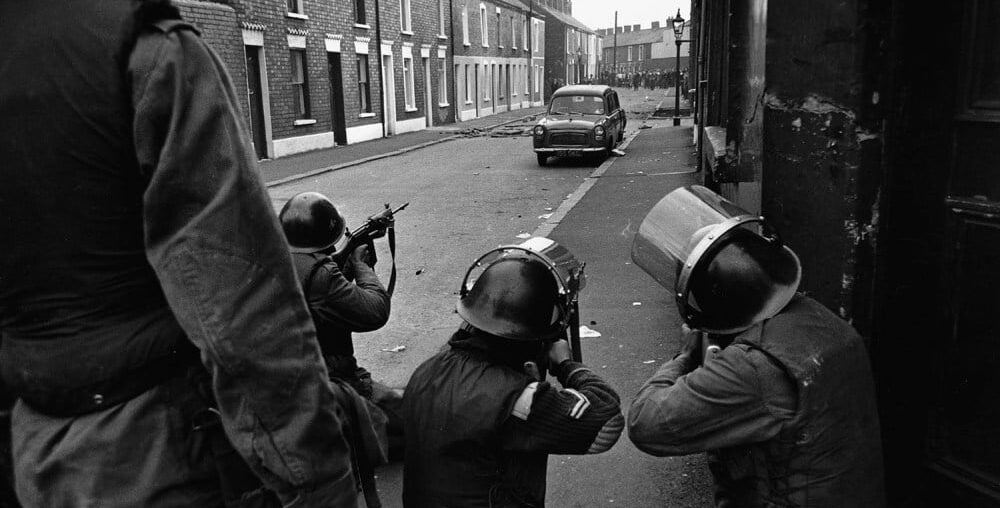
If the United States was to experience a descent into political violence comparable to the Troubles in Northern Ireland, the results would be catastrophic. Between the late 1960s and the late 1990s, the conflict claimed 3,500 lives in a region with a population of about 1.5 million. Adjusted for population size, this would be the equivalent of more than 700,000 deaths in the present-day United States. But even political violence on a smaller scale raises an important question about the state security forces tasked with upholding the law. Can they be relied upon to do so without taking sides in a bitterly polarized environment?
Northern Ireland offers an important and disturbing case study in how far those who are supposed to protect ordinary citizens from harm can themselves become a threat to public safety. The British security forces during the Troubles were divided into several parts. Members of the regular police force, known as the Royal Ulster Constabulary (RUC), routinely bore arms while on duty, unlike their counterparts in Britain. They were supported by soldiers from the British Army and by a part-time militia, the Ulster Defence Regiment (UDR). Members of the RUC and the UDR were overwhelmingly recruited from within Northern Ireland, with the vast majority coming from the Protestant-unionist community.
These forces had to deal with paramilitary groups that challenged the authority of the state. The Irish Republican Army (IRA) carried out attacks on the security forces, killing hundreds of soldiers and police officers as part of its campaign for a British withdrawal from Northern Ireland. The loyalist paramilitaries of the Ulster Volunteer Force (UVF) and the Ulster Defence Association (UDA), on the other hand, accused the security forces of not doing enough to combat the IRA and took the law unapologetically into their own hands. Although the IRA was their declared adversary, in practice, the loyalist groups generally targeted civilians from the Catholic-nationalist community. About 85 percent of those killed by loyalists were civilians; the equivalent figure for republicans was 35 percent.
The security forces and their political masters in London always insisted that they were upholding the rule of law in Northern Ireland against all those who sought to undermine it. But there was clear evidence of double standards in their approach to republican and loyalist paramilitaries. To begin with, the British authorities allowed the UDA to remain a legal organization for two decades until it was finally banned in 1992. In the 1970s, it was official policy to permit members of the UDA to join the UDR. A memo from the British Army’s headquarters in Northern Ireland circulated in 1972 stated that the UDA was “a large organization not all of whose members can be regarded as dangerous extremists,” and that it would be “counter-productive to discharge a UDR member on the grounds that he is a member of the UDA.”
During the ’70s, serving members of the RUC and the UDR formed part of the so-called Glenanne gang, a loyalist militia responsible for some of the most notorious atrocities of the time, including the bombings that killed 33 people in Dublin and Monaghan in 1974. Some of the killings by the Glenanne gang were investigated by the Historical Enquiries Team (HET) of the RUC’s successor force, the Police Service of Northern Ireland. The HET report noted a widespread belief among relatives of the gang’s victims that the RUC did not investigate its activities properly at the time, “in a deliberate effort to conceal security forces’ involvement and perpetuate a campaign of terror by loyalist paramilitaries.” The HET declared itself to be “unable to rebut or allay these suspicions,” having identified “disturbing omissions and the lack of any structured investigative strategy,” not to mention “indisputable evidence” of collusion between loyalist paramilitaries and members of the security forces that should have “rung alarm bells all the way to the top of Government.”
At this point, only people who are willing to ignore the vast amount of evidence from official sources in the public domain can still deny the existence of large-scale collusion between loyalist paramilitaries and the state forces in Northern Ireland. This story unfolded in a West European state renowned for its long, unbroken tradition of constitutional government, in contrast with neighbors such as France, Spain, and Germany. It should stand as a permanent warning of how far those responsible for enforcing the law can deviate from their stated mission in the face of a political crisis.
The reports produced by various official bodies since the Good Friday Agreement of 1998, including the HET and the Police Ombudsman, have greatly added to our knowledge of collusion during the Troubles. However, these revelations did not come out of nowhere: Members of the nationalist community and their political representatives repeatedly leveled charges of collusion against the security forces while it was taking place, only to have those charges dismissed as slanderous conspiracy theories by successive British governments.
This was when, as the HET later pointed out, there was “indisputable evidence” of what was happening available to the politicians and civil servants responsible for governing Northern Ireland. Government officials kept that evidence hidden from the public at a time when it was most important for it to be widely known and discussed. The institutions capable of investigating collusion and other abuses were only created after the conflict was over (and even then, they have faced many forms of obstruction from the highest levels of the British state).
Northern Ireland’s experience drives home a lesson that should be familiar from many other countries and conflicts: Those in positions of power simply cannot be trusted to scrutinize themselves, least of all in the middle of a full-blown conflict. Only the existence of genuinely independent bodies can hold those in power accountable and serve as a check on abuses like the kind we saw during the Troubles.

